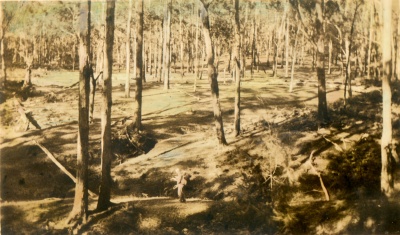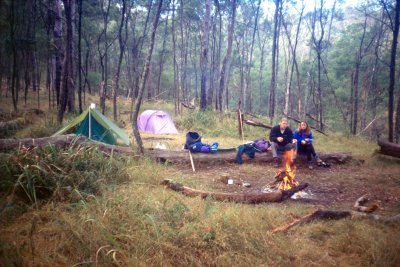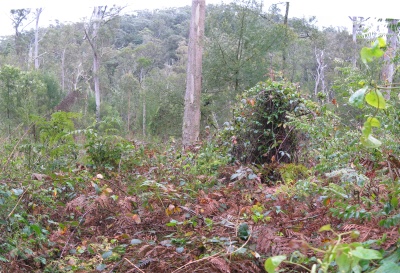
Circa 1933. A. H. Pelham collection
SummarySaint Helena Crater, near Glenbrook in the Blue Mountains, played a significant part in conservation and bushwalking history. Off the radar for many years, the crater now has a huge weed problem. A plan has been set in motion to fix it, but it needs your help, and your club's help.
 Circa 1933. A. H. Pelham collection |
One of the places I remember most fondly was Saint Helena Crater. It was beautiful. Picture green grass, with tall white columns of gums reaching up, branchless for many metres, to support a green cathedral ceiling with gnarly organic arches. The dappled shade covered lush grass groomed by wombats and kangaroos. No matter where you camped in the crater the views were picturesque and serene. Saint Helena Crater was not especially difficult to get to by the mid 1970s, but not frequently visited, either.
A semi-circular basin of an area of about 30 acres lying about 325 feet below the surrounding plateau sandstone level. Filling largely tuffaceous. Olivine basalt at lowest point exposed by drainage channel which has sawn through the sandstone rim and removed the neck filling to a depth over 300 feet. Well grassed forest land, its presence unsuspected, even at a short distance.
Thirty years later, a description of Saint Helena Crater was given in the Blue Mountains Daily on 24 March 1939, in a feature called “Rambling around Springwood”, which reads in part
St. Helena, several miles along the quiet, charming Western Creek is an extinct volcano. [...] It [is] a circular valley of about one mile in diameter. The green grass gives evidence of the fertility of the soil. It is very similar to ‘Valley Flats’ [Sun Valley] but more wooded and practically hidden from sight.
 April 1994. Photo: B. Cameron. |
Saint Helena Crater was granted by the terms of a permissive occupancy to the Federation of Bushwalking Clubs around April 1941. Over 100 acres surrounding the crater were granted. It was reported in April 1941 that the area
was pioneered by the Warrigal Club amongst bushwalkers [and that the crater] is an attractive and unique feature from the point of view of geological and botanical study and the [lease] will permit of some control being exercised over it to prevent spoilation and destruction of these special features.
The ultimate goal of the Warrigal Club was realised when the Blue Labyrinth was gazetted as part of the Blue Mountains National Park in 1959.
The above material in this section is from: Cameron, B., (1992) “A History of the Blue Labyrinth”. Used with permission.
Saint Helena Crater was a popular destination for bush walkers in the era before affordable motor cars, when proximity to railway stations was essential. Many clubs, and the Federation of Bushwalking Clubs, held annual reunion trips, often over the October long weekend, and Saint Helena Crater was a frequent reunion venue. The motor car started to become affordable in the 1950s, and bushwalkers were able to go further afield, in search of new and previously unreachable wilderness. Saint Helena Crater saw fewer and fewer vistors, perhapse in part because it was too easy with the new fire trails cut in the 1960s, or tired and overworked in the eyes of trip leaders. Whatever the reason, in a few short decades the crater faded from the minds of men, and disappeared into the darkness.
Blackberry, Rubus fruticosus agg.“Blackberry is a Weed of National Significance. It is regarded as one of the worst weeds in Australia because of its invasiveness, potential for spread, and economic and environmental impacts. Blackberry has invaded the banks of watercourses, roadsides, pastures, orchards, plantations, forests and bushland throughout temperate Australia. [...] Blackberries also affect tourism, reducing the natural attraction of the bush and hindering recreational activities where thickets prevent access to natural features.” (weeds.gov.au)
 July 2008. The foreground is blackberry and bracken. Note the thin crowns of the few trees and the standing skeltons. Photo: P. Miller |
There are some open grassy areas on the north western side, which appear to be each centered on a wombat burrow. These grass foraging areas are not pristine, however: they are infested with Cobblers Pegs, Bidens pilosa. Ironically, the few wombats that survived the fire (it raged, unstoppable, for several days) may have been saved from starvation by the quick growing fresh blackberry shoots.
Far from a wilderness jewel, the Saint Helena Crater of today is an ugly brown scab. There are standing skeletons of trees which did not survive the 2002 fire. There are fallen trees and dropped branches everywhere, mounded over by blackberry. The few surviving trees have few limbs and very thin crowns. These proud gums have few saplings. The watercourses are choked with blackberry. The old dam is a fetid swamp, surrounded by more skeletons, more reminiscent of an Adams Family water feature than an idyllic picnic spot. Even the green swathes of bracken, scattered all about the crater, are misleading, as every one of them is laced with blackberry, just waiting to ensnare the unsuspecting bushwalker.
Will we, in our turn, leave a legacy to be treasured? Your help is urgently needed to restore Saint Helena Crater to its former state.
It is not sufficient to simply spray the weeds and consider the job as done. This will only result in a different crop of weeds. To restore Saint Helena Crater will take many years of careful bush regeneration. Yes, it will kill the blackberries and the cobblers pegs, but those will be side effects of restoring the crater's natural balance of plant communities, not goals in themselves.
As bushwalkers we often see ourselves as separate from bush regeneration; we go where the land is unspoiled and wild. As bushwalkers we often see weeds in National Parks as a NPWS problem, or a local council problem, because we pay our taxes and council rates, and surely some of them pay for rangers to pull weeds. As bushwalkers we often see bush regeneration as recreational weeding, an urban hobby, nothing to do with our real bush.
In the most literal sense Saint Helena Crater needs bush regeneration. It needs its endemic native plant species to be regenerated. There are over thirty such sites, big and small and huge, scattered across the Blue Mountains National Park, and only a handful of rangers and volunteers to deal with it. Whatever your views of the politics and policies of NPWS, the reality is that Saint Helena Crater will not be regenerated without volunteers.
Those volunteers can't come from urban bush regenerators, they are already fully occupied in their local urban areas. It can't come from the local council staff, they are already fully occupied on council problems. It can't come from the local NPWS staff, they are already fully occupied on all the other environmental disaster areas in the Park. It has to come from us, the folks who walk in and walk out, bushwalkers who want to visit remote and beautiful places, the people who already know to carry out their garbage, folks who can see the jewel beneath the scab.
“But,” you say, “why should I care about a place I don't use?” Saint Helena Crater was, and can be again, an excellent introduction to overnight camping for beginners. Expert and experienced navigators are no longer required to venture into this part of the Blue Labyrinth, but it's a good place to practice navigation skills. It was, and can be again, a beautiful place to while away a lazy weekend and avoid the chores, far from the madding crowd. And, in these days of spiraling petrol prices, you can still get there from a railway station.
What is needed is a pool of willing people large enough that we can bring together working-bees of 4 to 8 people twice a year, in spring and in autumn, to walk in to the crater (it takes about three hours from Glenbrook Station), spend two days tackling the problem, and walk out again. There is no vehicular access at all. You don't have to be qualified in bush regeneration, although that would be a bonus; we will need to have experienced people to give us some basic training. We will approach NPWS to pay for professional bush regeneration trainers to accompany the teams, as they do in some other areas.
“Eight people,” you say, “easy!” But, and this is a big but, this will go on for at least ten years, and we may need more trips in the early years. The point of recruiting clubs and not individuals is the social aspect: a club's members are already comfortable with each other, already come together for other events. It easier to sign up for a trip with people you know than it is to ring a coordinator you don't know, to spend a weekend with even more people you don't know.
So how about it — is your club prepared to put Saint Helena Crater working-bees on its official calendar? Is your club prepared to work with other clubs to synchronise calendars for the working-bees? When the job is done, does your club want the satifaction of having restored a significant piece of bushwalking heritage?
 Who is this bloke?
Who is this bloke? Why should he be the one to spearhead the regeneration of Saint Helena Crater?
“If not me, then who?”You can contact Peter Miller <pmiller@opensource.org.au> by email.
This page has been accessed approximately
 times since 2008-Aug-27.
times since 2008-Aug-27.